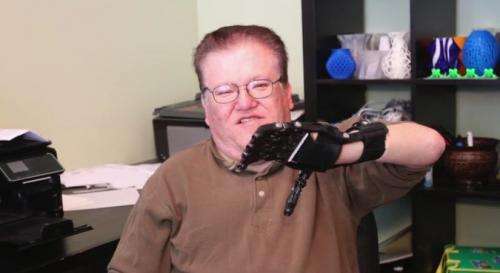April 22, 2014 weblog
Low-cost 3D printed hand suits man for daily needs (w/ video)

(Phys.org)—Jose Delgado, Jr., a 53-year-old man born without most of his left hand, has given positive feedback about a $50 3D prosthetic hand. He talked about all it can help him do in a video that was presented by the person who helped make the hand. Delgado's account, praising the hand for enabling good day to day functionality, made the rounds of tech sites this week. The story drew interest not only because this is a 3D-printed prosthesis but also because he said that, in a number of ways, he liked it better than his $42K myoelectric prosthesis. (A myoelectric-controlled prosthesis is an artificial limb that you control with the electrical signals generated naturally by your own muscles.) Delgado's myoelectric hand tapped into muscle signals on his arm to trigger the closing or opening of the fingers.
The story involves Jeremy Simon, founding partner at 3D Universe. Delgado asked if Simon could help make a 3D printed prosthesis for him. Simon worked with Delgado in developing a suitable 3D-printed hand. "Jose found his way to me and asked if I could help make a 3D printed prosthesis for him."
The total cost of materials for a 3D printed e-NABLE Hand, a mechanical design, was about $50. Acrylonitrile Butadiene Styrene (ABS) plastic, a common printing material, was used. This device design is referred to as the Cyborg Beast model.
Delgado and Simon got together again for some "fine-tuning," said Simon, of the tension on the tendon cords. These are fundamental to how the 3D printed device operates, as they are a series of non-flexible cords running along the underside of each finger, connecting to a tensioning block on the top rear of the device, the "gauntlet". Tension is caused by bending the wrist downward. With the wrist in its natural resting position, the fingers are extended, with a natural inward curve. When the wrist is bent 20 to 30 degrees downward, the non-flexible cords are pulled, causing fingers and thumb to bend inwards. A second series of flexible cords run along the tops of the fingers, causing the fingers to return automatically when tension is released.
When asked what he liked about the hand, Delgado said the 3D rendition enabled more fingers to function, and he liked the way the hand supported the gripping function of the steering wheel. He also was pleased with the way his prosthetic hand worked in gripping handles on grocery bags.
Simon said Delgado's feedback provided a unique perspective, as Delgado has been using multiple types of prosthetic devices including the myoelectric hand, for years.
It generally has been acknowledged in prosthetic design that recreating a human hand's functions is a technical challenge. The human hand is one of the body's more complex parts, with its muscles, nerves, tendons and bones. Nor can the 3D printed hand and the far costlier prosthetic device be considered an either-or proposition. "Since the prosthetic devices Jose has used are completely different types, his statements do not represent an apples to apples comparison. The comparison here is simply in terms of how useful Jose has found each device to be on a day-to-day basis."
Delgado works in an environment that involves a lot of box-lifting and moving. Simon had anticipated that the Cyborg Beast's ABS plastic might not hold up for long. "To my surprise, however," said Simon, "Jose says it's been doing very well."
Nonetheless, Simon said next on his to do list for Delgado will be printing another e-NABLE hand but using a Bridge nylon material. Simon said the Bridge nylon has enhanced strength properties while remaining lightweight. "I'll also provide him with an alternate thumb mount to enable a different kind of grip."
More information: www.3duniverse.org/2014/04/19/ … electric-prosthesis/
© 2014 Phys.org




















